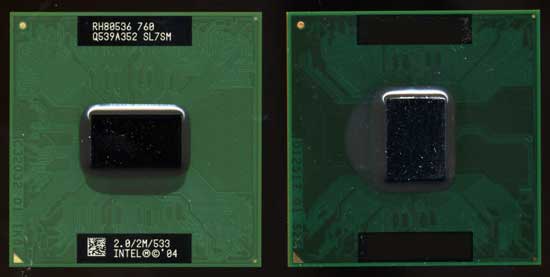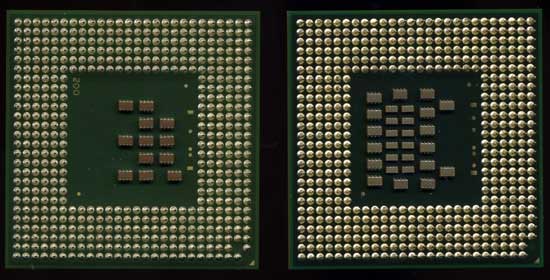Intel Core Duo (Yonah) Performance Preview - Part II
by Anand Lal Shimpi on December 19, 2005 12:55 PM EST- Posted in
- CPUs
It's called the Core Duo
When Yonah first started appearing on roadmaps, we knew it as Jonah, which then starting being written as Yonah. Eventually, Intel confirmed its existence and we had always assumed that it would continue to use the name Pentium M. However, given the great importance of the launch of Intel's first dual-core, low power, notebook processor, it shouldn't be much of a surprise that Intel has a new name in store for it. As you've probably already heard, Yonah will receive the marketing name "Core" with the words "Duo" or "Solo" following it depending on whether it is the dual or single core version. The name Centrino will still be there, but instead of referring to the processor as a Pentium M, it'll be called a Core Duo or a Core Solo. The Centrino platform itself will be referred to as Centrino Duo when paired with a Core Duo processor. We have to admit, we kind of like the new name.
Not so pleasant, however, are the new processor numbers that go along with the new processor names. Gone are Intel's simple three-digit numbers and they have since been replaced with a four-digit number preceded by a letter. The letter indicates the thermal envelope of the processor, while the following four digits denote the performance level of the CPU. If you think that this sounds oddly similar to AMD's Turion processor nomenclature, don't worry; you'd be completely right (of course, the Turion only uses two numbers, while Core Duo uses four). Maybe, one of these days, Intel will get around to copying some more important elements of AMD's history, such as an on-die memory controller or at least a serial bus interface.
As an example of the numbers in use, the 2.0GHz processor that we previewed in the first article will be sold under the name "Intel Core Duo T2500". For your reference, the T2600 will run at 2.16GHz (compared to the 2.0GHz T2500). The Core Solo processors will feature a "1" after the "T" denoting a single core; for example, the Intel Core Solo T1300 will run at 1.66GHz.
Intel's Core Duo and Solo processors both support a 667MHz FSB, which is enabled by the 945 chipset that Intel is pairing with them. The move to a 667MHz FSB is necessary, thanks to the increased bandwidth demands of a dual core processor.
As we mentioned in the first article, the Core Duo (and Solo) processors are not pin-compatible with the older Pentium M, even though they physically have the same number of pins.
When Yonah first started appearing on roadmaps, we knew it as Jonah, which then starting being written as Yonah. Eventually, Intel confirmed its existence and we had always assumed that it would continue to use the name Pentium M. However, given the great importance of the launch of Intel's first dual-core, low power, notebook processor, it shouldn't be much of a surprise that Intel has a new name in store for it. As you've probably already heard, Yonah will receive the marketing name "Core" with the words "Duo" or "Solo" following it depending on whether it is the dual or single core version. The name Centrino will still be there, but instead of referring to the processor as a Pentium M, it'll be called a Core Duo or a Core Solo. The Centrino platform itself will be referred to as Centrino Duo when paired with a Core Duo processor. We have to admit, we kind of like the new name.
Not so pleasant, however, are the new processor numbers that go along with the new processor names. Gone are Intel's simple three-digit numbers and they have since been replaced with a four-digit number preceded by a letter. The letter indicates the thermal envelope of the processor, while the following four digits denote the performance level of the CPU. If you think that this sounds oddly similar to AMD's Turion processor nomenclature, don't worry; you'd be completely right (of course, the Turion only uses two numbers, while Core Duo uses four). Maybe, one of these days, Intel will get around to copying some more important elements of AMD's history, such as an on-die memory controller or at least a serial bus interface.
As an example of the numbers in use, the 2.0GHz processor that we previewed in the first article will be sold under the name "Intel Core Duo T2500". For your reference, the T2600 will run at 2.16GHz (compared to the 2.0GHz T2500). The Core Solo processors will feature a "1" after the "T" denoting a single core; for example, the Intel Core Solo T1300 will run at 1.66GHz.
Intel's Core Duo and Solo processors both support a 667MHz FSB, which is enabled by the 945 chipset that Intel is pairing with them. The move to a 667MHz FSB is necessary, thanks to the increased bandwidth demands of a dual core processor.
As we mentioned in the first article, the Core Duo (and Solo) processors are not pin-compatible with the older Pentium M, even though they physically have the same number of pins.

Dothan (Pentium M) on the left, Yonah (Core Duo) on the Right

Dothan (Pentium M) on the left, Yonah (Core Duo) on the Right










103 Comments
View All Comments
Hacp - Monday, December 19, 2005 - link
If you want performance of an AMD X2 in a notebook package, the Yonah duo is the way to go.Griswold - Monday, December 19, 2005 - link
Or you wait for dual core Turion. Same thing.Accord99 - Monday, December 19, 2005 - link
But at 2-3x the power consumption.Houdani - Monday, December 19, 2005 - link
http://www.anandtech.com/cpuchipsets/showdoc.aspx?...">http://www.anandtech.com/cpuchipsets/showdoc.aspx?...No need to exaggerate unnecessarily.
Accord99 - Monday, December 19, 2005 - link
That's a system power consumption, I was referring to CPU only. And in a laptop environment, the power usage of the other components are much smaller so the impact of the CPU portion is greater. 90nm single Turions are already uncompetitive with Yonah, making them dual core will just make it worse.saratoga - Monday, December 19, 2005 - link
The difference will most likely be less then 2x judging by the relative power consumption of Dothan and Venice @ 90nm, so you're still wrong.Also, Yonah is a 65nm chip. It should not be surprising that it has an edge over 90nm chips.
Accord99 - Monday, December 19, 2005 - link
Dothan vs Turion ML has a 2X or greater edge under load. Yonah has comparable power consumption to Dothan while 90nm dual core Turions will clearly go up. 3X is not out of the question for non-undervolted DC Turions.Shintai - Monday, December 19, 2005 - link
Ye I would guess on something like 35W will be 40-45W with 65nm Turion X2, unless you sacrifice speeds. The 25W part might be 35-40W.But Turion really never had a chance, since it´s not designed for low power. And as we already saw in the benchies. Who want a dualcore Turion running at 1.8Ghz or less against a 2.13Ghz Yonah when the yonah uses less power.
Intel briliant move so Dothan->Yonah only gave 9% more transistors. Turion->Turion X2 will add 110-120% more transistors (Over 100% due to crossbar between CPUs).
So Yonah will also be cheaper to make than a dualcore Turion.
Furen - Thursday, December 22, 2005 - link
Intel did slice the "cache per core" in half with Yonah, so AMD could conceivably make Dual-core Turions have 512k per core, which would make the die-size increase around 50%, though this will probably have a greater impact on performance on the AMD side, since Dothan's cache was insanely huge to begin with.About the price: AMD Turions will always be cheaper than their direct analogs from Intel because AMD needs to perform the same AND have a better price for people to use it, otherwise they'll go with the market leader, so I dont think we'll ever be faced with chosing between a 1.8GHz Turion and a 2.13GHz Yonah. This is regardless of the production cost, though AMD's margins may take a big hit if Intel pushes prices hard enough.
bob661 - Monday, December 19, 2005 - link
pnw3d